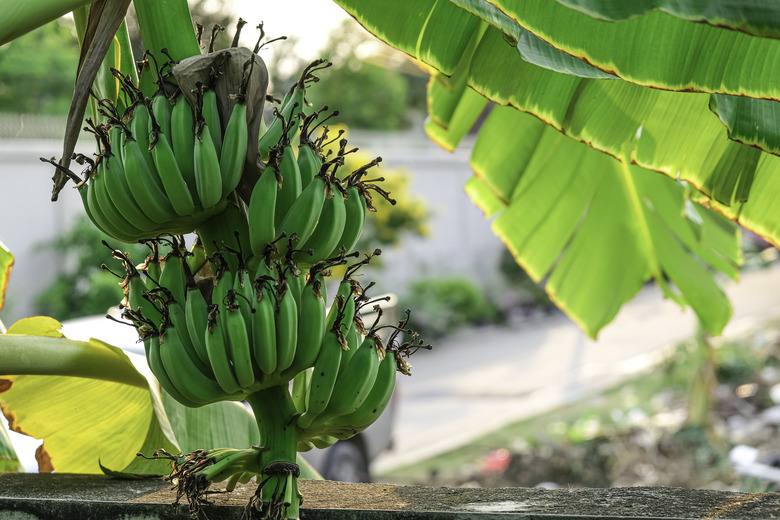How Long Does A Banana Tree Live?
We may receive a commission on purchases made from links.
Depending on how you look at it, a banana (Musa spp.) has either a short life or a very long one. Banana "trees" are actually perennial herbs — the largest in the world. Because they're not trees and because of the way they reproduce, the longevity of a single banana plant is short. But bananas are propagated via pups, or baby banana plants, that surface from the banana's underground rhizomes. So you might say that the actual life of a banana can be decades, as long as it's growing in favorable conditions and can continue to produce pups, which become the juicy stems on which the fruit appears.
Tip
From its first emergence from an underground rhizome to fruit harvest when the plant is cut down, a banana's life cycle spans only somewhere around 15 months to 2 years. However, because multiple banana plants continue to emerge from the same rhizome, you could also say that a banana stand can live for decades, if not longer.
The Life of a Banana
The Life of a Banana
Bananas grow from underground rhizomes — horizontal, juicy clumps beneath the soil with multiple nodes that surface to become new banana stems, called "pseudostems." They're frequently incorrectly referred to as trees or even palms. When a baby banana, or pup, surfaces, it's a clone of the mother plant, and it grows quickly to resemble its mama, with long, curled "cigars" that unfurl into large, broad leaves — sometimes as long as 9 feet, depending on the variety.
It can take from 12 to 18 months for this new plant to produce flowers, then another three or four months for the fruit to mature, depending on the weather. If the plant is growing in a colder climate and the fruit is forced to overwinter, the flower or fruit may die or at least be delayed in development.
After harvest, the banana plant is cut down. So you could say that, from its first appearance from an underground rhizome to harvest, a banana's life cycle spans only somewhere around 15 months to 2 years. Alternatively, if you consider the banana as a stand, as it is considered in commercial plantings, the entire stand may live 25 years or more.
Bananas in Your Backyard
Bananas in Your Backyard
Perhaps you're dreaming of a tropical paradise in your own yard and hope that the evocative banana fronds will play a starring role. If so, and if you live in U.S. Department of Agriculture plant hardiness zones 8 through 11, you're part of the way there. But a home gardener may find that growing bananas for fruit, rather than as ornamentals, creates a challenge. The growing conditions must be ideal and provide specific conditions: lots of warmth, full sun, enriched soil and plenty of water. And these ideal conditions must persist across the many months it takes to develop the flower and then the fruit.
To grow bananas for ornamental use, however, is a lot easier. Be sure to consider their expected size when you plant them, however, because they can grow quite large. As mentioned, plant them in well-drained, rich soil in a sunny location where they'll be shielded from drying or cold winds, and fertilize them regularly with a balanced fertilizer.
The young pups that emerge from the base of the plant can ultimately create a banana stand that "moves" over time, as you cut down old stems and allow new stems to take their place. If you find that your banana has migrated outside its desired location, dig out some of the healthier, young pups, and then remove the entire stand and replace it with the younger plants.
